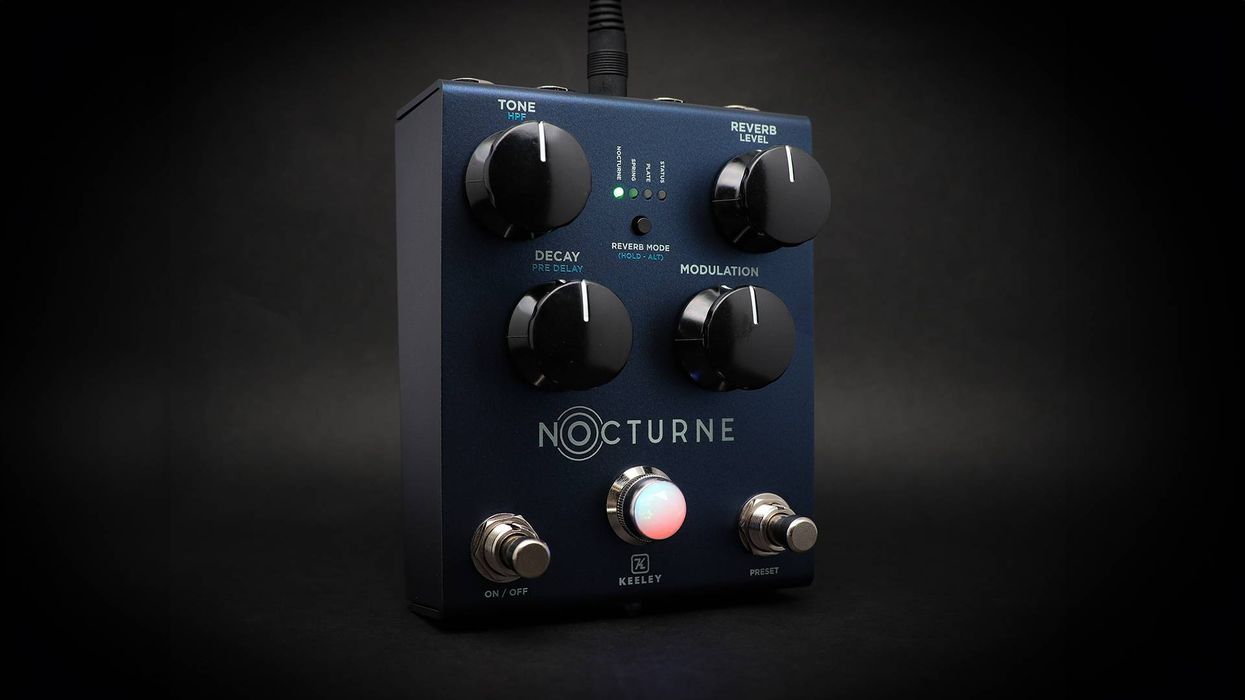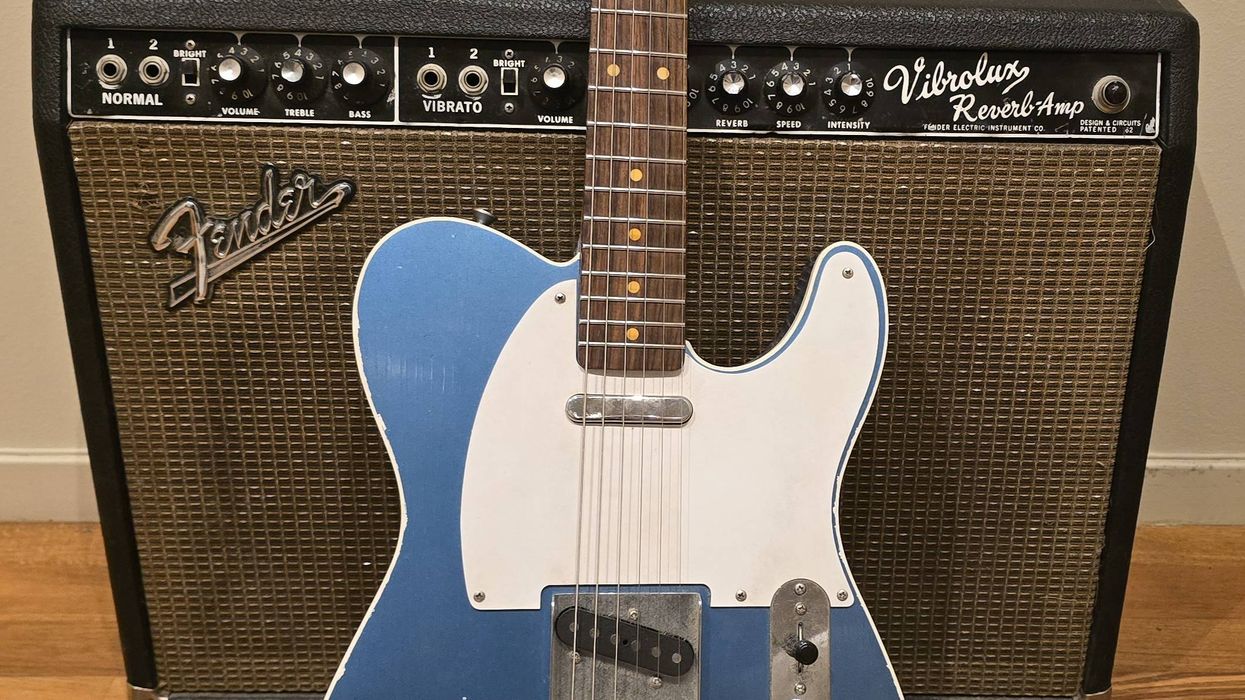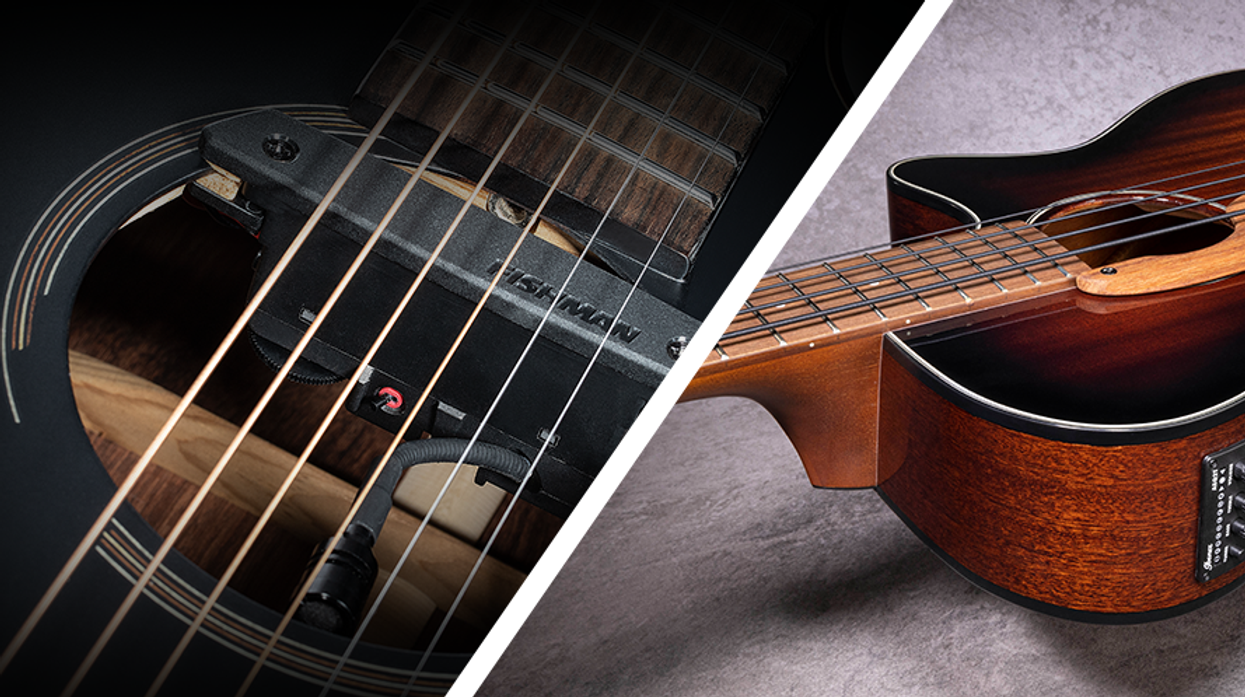The Chapman Stick is a strange and often misunderstood instrument. It’s not a guitar, bass, or keyboard, but, in a sense, it’s all three. This 10- or 12-stringed beast, invented in the early 1970s by the jazz musician Emmett Chapman, is played using a two-handed tapping technique, and despite how long it’s been around now, it’s still seldom seen onstage or in the studio—or anywhere else.
Relatively few players have fully realized the exciting possibilities inherent to the Stick. That’s what makes Stick Men—a band that includes two of the instrument’s most accomplished practitioners, Tony Levin and Markus Reuter, rounded out with the drummer Pat Mastelotto—such a force to be reckoned with.
Levin, who’s now 70, was an early adopter of the Stick, having taken up the instrument in the mid 1970s. An in-demand bassist, he’s played on some 500 albums by everyone from David Bowie to Judy Collins and Pink Floyd. But his virtuosity has long been most evident when he picks up a Stick, as he’s done extensively in his work with progressive rock artists like Peter Gabriel and King Crimson, as a solo artist, and in Stick Men.
At 44, Reuter might be Levin’s junior by three decades, but he’s no less a touch-guitar master. In the 1990s, Reuter emerged as one of the leading Stick/touch-guitar virtuosos, and since then, in addition to his work as a contemporary classical composer and record producer, he’s expanded his concept of the touch guitar to include extreme signal processing. He’s even designed his own instruments under the brand—you guessed it—Touch Guitars.
When Levin and Reuter get together with Mastelotto, as on Stick Men’s most recent album, Prog Noir, an uncanny music that draws from prog-rock, 20th-century composition, and modern jazz emerges. The touch guitars combine to form dizzying flurries of sound that leave even expert players wondering how they were created.
We chatted with the touch-guitar tandem about how they developed their voices on this unusual instrument and how they worked remotely—on two different continents, no less—to create a coherent album that sounds as if they recorded it together in the studio.
You’re both experts on a very nonstandard instrument. What drew you to the touch guitar—and how did you master it?
Markus Reuter: The instrument’s directness is what drew me to it.In a way, it’s easier than playing regular guitar because it’s much more immediate—you don’t have to coordinate the left and right hands to make notes. It’s really a wonderful thing, because you’re putting the finger down onto the string, the string hits the fret, and you get the note immediately. It’s like a piano without the keys. Somehow the musical intention—or you could even say the emotional expression—flows directly from the finger into the string. On a regular guitar it never really has that feeling.
When I started on the Stick, I saw that nobody really knew how to play it. So I created this body of exercises, which I called “The Family”because the etudes have names like “The Son,” “The Daughter,” etc. Basically, it’s a group of compositions that really teach you how to play the instrument. The research and development of this took over 20 years. I started in ’93 and am finally to a point where I can teach somebody to play Stick or touch guitar in a few days.
Tony Levin: I heard about the Chapman Stick and touch playing in about 1976. It sounded like an interesting way to get my bass playing into a new area, so I got one right away. I played only the bass side of it for years—with Peter Gabriel and King Crimson—and gradually grew to include the guitar side and writing material of my own with it, especially on my album Stick Man and the handful of albums with Stick Men.
Tony, how did you go about migrating to the guitar side?
Levin: The other strings were there all along—I just started playing them. Probably the first time I ventured to the guitar side was in King Crimson. Some of the pieces from the [1981] Discipline album had room for another guitar voice, as Adrian [Belew] and Robert [Fripp] were doing their interweaving thing.
What’s the range of your instrument compared to a standard guitar, and how many notes can you play at once?
Reuter: My instrument goes from a low Bb—below a 5-string bass—up to a high D, which would be the 22nd fret of the highest string on an electric guitar. It’s tuned in fifths. You can theoretically play up to eight notes with eight strings, but in actuality you usually play no more than six notes at a time. There’s an arpeggio-study piece of mine that you can find on YouTube called “Prelude” [Editor’s note: The full video title is “Alexander Dowerk & Markus Reuter: Prelude"], and you can see three notes per hand. That’s really what I would consider to be the maximum of what makes sense.
Now seems like as good a time as any to talk about your instrument company, Markus.
Reuter: I started a brand called Touch Guitars around 2007. My initial idea was to come up with an instrument that was affordable, but it turns out that the quality of a touch guitar needs to be very high in order for the [hammer-on] technique to work properly, so it wasn’t really possible to come up with a budget instrument. We have several different models at the moment: There’s a 10-string version, a couple of 8-string versions, and also a semi-acoustic 8-string, which I use onstage with Stick Men, because it’s just so incredibly responsive.
Speaking of Stick Men, what was it like when you met each other for the first time—and how did the group come together?
Reuter: I played with [drummer] Pat [Mastelotto] for a number of years before he introduced me to Tony at his place in Texas. I think it was in September 2010. Tony and I immediately had the greatest chemistry—we have shared classical backgrounds and really got along very well on that level. Quite a few of the pieces we play in our live set we actually wrote that very first day we met.
At first I wasn’t really sure if I was going to be strong enough onstage—robust enough to counterbalance the power of Pat and Tony, who are such iconic musicians. But after our first show together, in Argentina, I felt, “Oh, this is going to work.” The first couple years I tried to be a very solid player for them so that they could actually be the great musicians they are—I tried not to interfere with their greatness, let’s say.
Over the years things have developed in such a way that I’ve become an even member of the group and it is just wonderful now … the dynamic of us onstage. It’s a dream come true, really.
Levin: Having recorded the album Stick Man [2007] with multiple Stick parts, I was wanting to take it live and perform the music, but needed another player. So, Michael Bernier, an excellent player who lives nearby [in upstate New York], seemed ideal—and, of course, so did Pat, my King Crimson bandmate who had played on the album. But after a few years of touring, Michael needed to be home more than the band could handle, and we made the change to Markus on his self-designed touch guitar. Since then, we’ve had many tours and albums, and we’re very gratified to be playing our music around the world.
How does the arranging process work with two touch guitars?
Levin: Most start with Markus or me writing a piece, laying down some parts, and then passing it on to Pat. Sometimes the original parts stay the same, but often there are changes—melodies added, sections added. There are some pieces where Markus wrote a melody on top of what I had done that I liked so much I wrote lyrics to it and it became a vocal piece.
Do you have to really work to stay out of each other’s way or do things just happen organically?
Reuter: It’s kind of happening organically, because even though we both play instruments that cover the full range, we still compose pieces with certain roles in mind for the part that each of us is playing. When Tony has a chordal idea with a bass part, then obviously I’m going to write the melody. In the process it’s always pretty obvious what is missing, and then the other player fills in that gap. When we then take stuff on the stage, obviously sometimes we change things around. For example, when Tony has to sing a part, I might take the chords—even if he played them on the recording—then, when I play a lead part, he takes the chords. The roles basically go back and forth all the time, which is sometimes confusing for the audience, but I think it’s fascinating.
What have you learned from all of this back and forth with each other?
Reuter: The mere fact that we have the opportunity to perform so much has made us evolve together with these instruments. I think both Tony and I have come to a point where the touch instrument has become a real musical instrument and not just a gimmick. Really that’s what makes it so special for me—that we’re actually playing real music with these new instruments.
Levin: I’ve always been impressed with Markus’ innovative way of playing and writing. He also has terrific technique and is very reliable, in concert, to do things right—much more so than I am!
Tony Levin was an early adopter of Emmett Chapman’s invention, using the Stick on influential albums by Peter Gabriel and King Crimson. He also invented “Funk Fingers”—modified drum sticks used for tapping the bass strings. Photo by Robert Juckett
Can you talk about how Prog Noir came together, and about some of the ideas that bind the record?
Reuter: When we started talking about the new record and didn’t have material yet, we decided that we wanted some sort of cyberpunk concept, and to work with lots of polyrhythmic activity between our hands. There are a couple of pieces on the album, like “Mantra” and “Embracing the Sun,” which really illustrate this concept. Then there are other pieces that were written entirely intuitively and melodically.
I wrote most of the previous album, Deep, and didn’t want to repeat the same process. We decided that Tony should write the majority of the starting points on this record. Tony would send an idea, or sometimes almost a complete song. Then I would play parts of it—sometimes just improvising, and then taking the improvisation as the seeds for the composition of my parts.
We never tell Pat what to play, and sometimes he would surprise us by changing the whole rhythmic feel of a song—putting a shuffle on top of something we thought of as straight, for example. It’s really highly interactive and we’re very much connected as people, even though we might not even see each other when we’re working on these pieces. We’re mostly working at a distance when we’re not on the road.
Levin: Quite a few compositions were things I’d been working at for years—especially the lyrics—so I had some of them pretty worked out on my own. But still there was time and mindset to change them in some instances. And, as usual, there were a few good pieces that didn’t make it to the album for various reasons.
As its name suggests, the album turned out kind of dark.
Reuter: Yes. It’s like when you’re on the road, you’re in the van, and it’s raining and black outside. All you see are headlights, and there’s a certain kind of feeling being on the road, playing for people and sacrificing parts of your life for your music. We wanted to represent this kind of melancholy on the album, and I think we succeeded with that. It’s on one hand dark, but on the other hand somewhat hopeful and playful.
Tony Levin’s Gear
Instrument
• 12-string Chapman Stick
Amp
• Kemper Profiler
Effects
• Analog Man Bi-CompROSSor
Instrument
• Touch Guitars AU8
Amp
• Tech 21 SansAmp Para Driver DI
Effects
• Dedalo Tres Tremolo
• Dr. Scientist The Elements
• Electro-Harmonix Pitch Fork
• Red Panda Context
• Red Panda Particle
• ZVEX Mastotron
• Alesis QuadraVerb2
• Boss SY-300
• Electro-Harmonix C9 Organ Machine
• Jack Deville Dark Echo
• Red Panda Subdivision
• Tech 21 Red Ripper
Strings and Picks
Content
You mentioned recording remotely. How does that work—do you email each other scores or audio files?
Reuter: Mostly recordings. Both Tony and I write music [in notation], but whenever we share something we actually record the ideas and then use Dropbox or something to just share the thoughts.
Do you then get together and practice for a few days before recording?
Levin: Making the album, we actually decided to have two periods of Markus and me together. We did one near the beginning in Berlin for a week. I had written a few songs at that point, but wanted to bounce them off Markus and also try some experimental things, at the same time giving some Berlin flavor to the music. Then, near the end of the writing process, he joined me in Kingston [New York] for a few days in my home studio, again developing things, adding new pieces, and homing in on the sound, feel, and sense the album would have.
Reuter: But we mostly even record at a distance. It’s funny—it doesn’t sound like it, right?
Not at all—the album sounds live.
Reuter: We have so much experience playing together that we can somehow recreate the feeling even if we’re not in the same room. I guess its part of my production, too. I try to make things sound live even though it’s being recorded at a distance. The whole approach is to make it sound organic—not just organic, but also exciting.
What sorts of things did you do as producer to achieve those ends?
Reuter: I basically take performances and re-amp them, and I have a couple pedals where I’m turning the knobs as I’m rerecording. The re-amping process becomes a performance in itself, and that’s how I treat all the sounds in the mix. I actually create maybe three, four re-amped versions of each track, including the drum tracks, with all sorts of crazy effects. In the mix, the signal creates this extra dimension that you wouldn’t really get if you were just working with static performances.
How do you feel about the mixing, Tony?
Levin: I know that my Stick sound, which I’d already worked on while recording, definitely changed in the mix—and in a good way. So it’s fair to say that we’re always trying to improve on the sound of a track, and with a lot of mutual respect. There’s no competition on who does the changing or has the last say. That’s one of the hallmarks of a band that’s fun to be in.
How does improvisation factor into the record, if at all?
Levin: There are no improv pieces per se on this album, but in the past we’ve done pieces that were completely improvised and even an entire album [2012’s Open] that way. But of course there’s Markus’ soloing, which was improvised as he recorded it.
Reuter: There’s always a great deal of improvisation in everything I do. Most of the parts I’ve written are actually sparked by improvisation. In a way, I’m trying to always improvise just to keep things fresh for myself. Sometimes it’s just a little detail that’s being varied when I play a piece. On the record, there’s a lot of stuff happening in the background, if you pay close attention. A lot of micro sounds, a lot of details, a lot of glitchy things. All of those were done on the first take and everything is improvised. Mostly I didn’t even know which key things were in, and I just played a few notes and they become the backdrop. That’s also how we create this harmonic complexity, by allowing, for lack of better words, random notes.
So there was some indeterminacy, like in a John Cage piece?
Reuter: Exactly, yes.
It’s particularly noticeable on the title track.
Reuter: Yes. You have both the 7 and the b7 of the chord, and the 6 playing at the same time in the background—this cool cluster of notes. You can hear things like this all over the place on the record—odd details that were improvised in the background. I did most of these atmospherics on the record using a Red Panda Particle pedal.
What is it that you like about the Particle?
Reuter: Really the random functions it has, because you can send the same signal to it twice and it will create different results. It is a highly digital pedal but it feels really, wonderfully analog. Some people might not know what to do with it, but I think it’s very, very useful to have something that is a little unpredictable and just sounds great. It’s just so highly inspiring. I cannot recommend it enough.
Levin: We’re really only getting started preparing to play the album live. We’ve done some of the pieces in concert before, but not all of them. It’s always a challenge, once you’ve fine-tuned a record, to look at how to do it live.
Reuter: Basically what we have to do when we go on the road is to break things down into the parts that best represent what you hear on the album. Then anything that’s happening on top is a bonus that makes it even better. Sometimes that means a part will get extremely simplified on the road. Things that work well in the studio don’t always work as well onstage. We can also prepare some of the atmospherics that the Particle created as samples, and Pat can trigger them during the show. But really, the pieces are living things that can evolve in concert—surprising the audience as much as they do us.
YouTube It
Tony Levin and Markus Reuter swap roles constantly as they romp through an arrangement of Igor Stravinsky’s The Firebird Suite in this 2012 performance from Kiev, Ukraine.












![Rig Rundown: Russian Circles’ Mike Sullivan [2025]](https://www.premierguitar.com/media-library/youtube.jpg?id=62303631&width=1245&height=700&quality=70&coordinates=0%2C0%2C0%2C0)













![Rig Rundown: AFI [2025]](https://www.premierguitar.com/media-library/youtube.jpg?id=62064741&width=1245&height=700&quality=70&coordinates=0%2C0%2C0%2C0)




















 Zach loves his Sovtek Mig 60 head, which he plays through a cab he built himself at a pipe-organ shop in Denver. Every glue joint is lined with thin leather for maximum air tightness, and it’s stocked with Celestion G12M Greenback speakers.
Zach loves his Sovtek Mig 60 head, which he plays through a cab he built himself at a pipe-organ shop in Denver. Every glue joint is lined with thin leather for maximum air tightness, and it’s stocked with Celestion G12M Greenback speakers.











